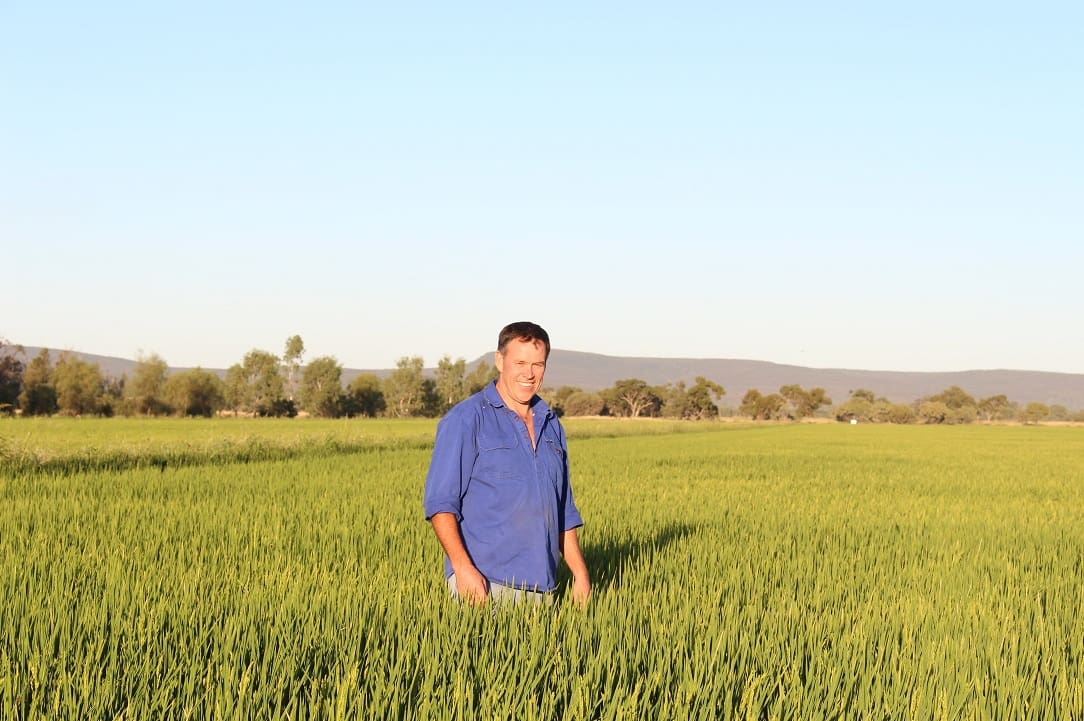
NSW rice grower, Mark Groat, says the rice industry must focus on increasing water use efficiency (WUE) both in terms of production per megalitre and return per megalitre.
MAKING the most out of every drop of water is key to the survival and growth of the Australian rice industry and an urgent step-change is required for the industry to thrive into the future.
That’s a key research finding of NSW rice grower and 2017 Nuffield Scholar Mark Groat, who with support from AgriFutures Australia travelled across the United States, South America, China and India drawing comparisons and insights for rice production back in Australia.
Mr Groat’s report outlines that with lower water allocations and higher water prices posing major challenges for the rice industry, increasing water use efficiency (WUE) both in terms of production per megalitre and return per megalitre must be a critical focus.
“It’s about gaining a greater return for the water used, whether that’s in terms of yield, quality, consumer demand, or company reputation,” he said.
Exploring the role of genetic enhancement of rice, the report looks at the successes of both short-season rice varieties and a system of stubble management implemented in North-West India.
“Shortening the season by developing 110-day rice varieties (instead of the conventional 140-day variety) enables planting to be delayed by a month, avoiding extreme heat during the mid-May – June period,” he said.
“The added benefit of bringing planting closer to monsoonal rains of late June allows water use to be decreased by 35 per cent without compromising yield.
“Winter crop rotation and stubble management has also dramatically increased WUE while enhancing soil characteristics in the region.
“As is the case in Australia, looking at the system as a whole, rather than the individual crop, is key.”
International comparisons
Mr Groat’s report also features a series of comparative case studies from international rice growing regions with similar geographic and climatic traits as Australia, such as the United States’ Mississippi Delta, Uruguay, North-East China and North-West India.
“We are world leaders in terms of rice yield per hectare, but I wanted to better understand how we compare to the rest of the world in terms of our water use efficiency,” he said.
“In the Mississippi Delta, the majority of water is pumped from the Mississippi River Valley alluvial aquifer with no regulation on extraction, and no charge for water.
“This has led to largely inefficient water usage and aquifer depletion by between 0.15 and 0.45 metres per year.
“Efforts in the region to address aquifer overdraft are aimed at irrigation efficiency, however uptake has been very low.”
Competing for water
A number of case study comparisons reveal Australia to be a leader in efficient and sustainable rice production, but the report concludes that the free market system of water in southern rice growing regions means rice is just another crop competing for a finite resource.
“Benchmarking of Australian data shows an identifiable yield gap of two tonnes per hectare between the average and top 20 percent of growers,” Mr Groat said.
“Identifying and addressing causes of this gap, decreasing evaporation and increasing marketability are key components to increasing WUE in terms of dollars per megalitre.”
Ultimately, the report recommends the industry re-focus on benchmarking, extension and research into in-situ stubble management.
“This is an extremely challenging time for the Australian rice industry, but it’s also a time of immense opportunity,” Mr Groat said.
“The combination of technology, irrigation design, crop protection products and rice genetics has opened the door to maximising WUE like never before.
“If as an industry we can focus on effective in-situ stubble management, identify and prioritise extension services on yield gaps, re-evaluate our research priorities and better tell our story, then we will be better placed to seize the opportunities before us.”
Video: Mark Groat presents his research findings at the 2018 Nuffield Australia National Conference.
Source: Nuffield Australia

HAVE YOUR SAY